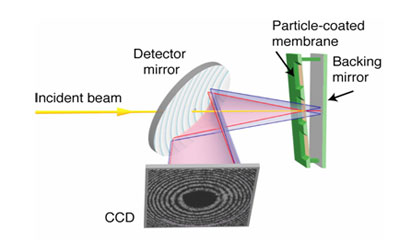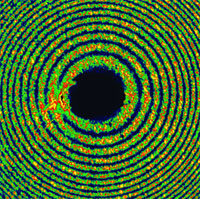X-ray free-electron lasers (XFELs) will produce photon pulses with a unique and desirable combination of properties. Their short X-ray wavelengths allow penetration into materials and the ability to probe structure at and below the nanometer scale. Their ultra-short duration gives information about this structure at the fundamental time-scales of atoms and molecules. The extreme intensity of the pulses will allow this information to be acquired in a single shot, so that these studies can be carried out on non-repeatable processes or on weakly-scattering objects that will be modified by the pulse. A fourth property of XFEL pulses is their high transverse coherence, which brings the promise of decades of innovation in visible optics to the X-ray regime, such as holography, interferometry, and laser-based imaging. Making an effective use of XFEL pulses, however, will benefit from innovations that are new to both X-ray science and coherent optics. One such innovation is the new method of time-delay X-ray holography [i], recently demonstrated at the FLASH FEL at DESY in Hamburg, to measure the evolution of objects irradiated by intense pulses.
One of the pressing questions about the high-resolution XFEL imaging and characterization of non-periodic or weakly-scattering objects is the effect of the intense FEL pulse on the object, during the interaction with that pulse. The method of single-particle diffraction imaging [ii] requires a stream of reproducible particles (e.g. a protein complex or virus) inserted into the beam, whereby a coherent X-ray diffraction pattern is recorded. The pulse will completely destroy the object, but if the pulse is short enough the diffraction pattern will represent the undamaged object. This ultrafast flash imaging was demonstrated at the FLASH FEL using test objects that included microfabricated patterns in silicon nitride foils [iii]. Those experiments showed that no damage occurred during the 30 fs duration pulse. However, in those experiments the imaging resolution was limited by the long 32 nm wavelength at which the facility was then operating. We wished to dramatically increase our sensitivity to the particles' explosions, to be able to increase the understanding of the dynamics of particles and predict the imaging performance at XFELs such as the LCLS. This was done in two ways in a single experiment: by holographically measuring the time evolution of the particle at times after the pulse had pass through the object; and by making an interferometric measurement of the change in the optical path through the object. The experimental technique, time-delay holography, achieved a time resolution better than 3 fs, and a phase sensitivity of better than 3°, or a sensitivity of < 3 nm of the expansion of the particles.
The idea behind time-delay holography is to use the same pulse that initiated the interaction with an object to probe that object at a later time. This was achieved simply by placing a mirror behind the object to send the pulse back on the object a second time. The time delay is easily set by the distance between the mirror and the object. This geometry is in fact the same as the `dusty-mirror' experiment that was first carried out by Newton. Newton's observations of light and dark rings formed when reflecting a shaft of sunlight from a dusty mirror back through a hole in a screen, was one of the earliest recorded of interference. The explanation for the effect was not forthcoming until a century later when Thomas Young explained these as interferences of waves traveling along two paths: 1) incident on the mirror, scattering from a dust particle before passing through the mirror glass and reflecting its back surface (which was silvered with mercury); and 2) first passing through the thickness of the glass of the mirror, reflecting, and then scattering from the particle on the way out. Further, experiments, performed with clouds of wig powder, confirmed Young's hypothesis.

We manufactured a multilayer with a broad reflectivity rocking curve to use as the object backing mirror. Both the direct beam and the wide-angle scattered wave from the object reflect from this mirror. The reflected direct beam, on hitting the object for a second time, creates another scattered wave. This wave, however, carries structural information about the object at a later time than the initial interaction. If the object had expanded in this time, for example, the second diffracted wave would be more forward-peaked. The two scattered waves (the first from the undamaged object, the second a well-defined time later) propagate together and are detected on a CCD. Now, even though the pulse hit the object at two distinct times, the two waves generated by these events do travel together and interfere with each other at the detector. This interference is dominated by a distinct ring pattern, which is the interference of two spherical waves that are longitudinally displaced. With many objects placed in the beam, each one generates an interference pattern which then coherent adds with all others, modulating the ring pattern with a speckle pattern. The ring pattern accurately encodes the distance between the spherical waves, which can be determined to high accuracy. From this distance the delay between the events can be determined to better than 3 fs.
The sample in our experiments consisted of an array of hundreds of silicon nitride membrane windows on which 140-nm diameter polystyrene spheres were placed. This was sandwiched against the multilayer backing mirror, positioned with a slight wedge to be able to vary the delay simply by moving to different membrane windows. The smallest gap was about 50 micron, to give a delay of about 300 fs, and the longest gap gave a delay of 8 ps. Each window gave the opportunity for several separate exposures. Even though the 20-micron-wide focused FEL pulse ablated a crater in the backing mirror and melted a hole in the silicon nitride, the entire window did not shatter so we could simply move to a new spot.
We consider the recorded diffraction pattern as a hologram, as it consists of the interference of a known reference wave (the undamaged object) with an unknown object wave (the object undergoing an explosion). The holograms were initially analyzed by considering the intensity of the interference between these waves as a function of scattering angle, or momentum transfer q. This was compared with calculated patterns, using a hydrodynamic model [iv]. We see that, as predicted, the patterns become narrower and more forward peaked as the time delay is increased beyond 3.8 ps. This suggests that in real space the objects are indeed expanding following the interaction. Furthermore, the evolution of the structure factor of the polystyrene sphere is in good agreement with our calculations to the longest-measured delays of 8 ps where the sphere has approximately doubled in size.

At delays shorter than 3 ps the expansion of the sphere was less than the transverse spatial resolution of 60 nm and hence could not be observed. However, changes in the optical properties of the sphere could be observed for delays even shorter than 1 ps. This is due to the interferometric nature of the measurement. The wave scattering from a polystyrene sphere is phase shifted by an amount that depends on the sphere's refractive index and (at low q) its thickness. If these properties change by the time the pulse returns to the sphere then the phase shift on scattering the second time will be different to the first. This relative phase shift will cause a change in the ring fringe pattern of the hologram. For example, a change in the phase shift by p (half a wave) would reverse the contrast of the fringes by causing constructive interference where there would have been destructive interference. The relative phase can thus be determined from the positions of the ring maxima and minima. We observed an increase in the phase shift with time delay and for increasing pulse fluence. At a delay of 350 fs the change in phase shift was equivalent to an increase of the optical path by less than 1/50th of a wavelength. Since the refractive index is negative (and close to unity) this corresponds to a reduction of material projected through the ball as would occur if the sphere expanded in all directions by 3 nm.
The experiment achieved this high level of precision in space and time without any complex optics or diagnostics, simply by utilizing the coherence of the pulse and the geometry of the `dusty mirror.' Other geometries are planned in for future X-ray FELs, using grazing geometries for shorter X-ray wavelengths and shorter time delays. The technique should be applicable to the high-resolution measurement of shocks, crack formation, ablation, melting, ultrafast phase transitions, and plasma formation.
Experiments were carried out at the FLASH FEL in DESY, Hamburg, by a collaboration of scientists from LLNL, Uppsala University, SLAC, LBNL, and TU Berlin. This work was performed under the auspices of the U.S. Department of Energy by Lawrence Livermore National Laboratory under Contract DE-AC52-07NA27344.
i. H.N. Chapman et al., "Femtosecond time-delay x-ray holography," Nature 448, 676-679 (2007).
ii. R. Neutze, R. Wouts, D. van der Spoel, E. Weckert, and J. Hajdu, "Potential for biomolecular imaging with femtosecond x-ray pulses," Nature 406, 753-757 (2000).
iii. H.N. Chapman et al., "Femtosecond diffractive imaging with a soft-x-ray free-electron laser," Nat. Phys.,2, 839-843 (2006).
iv. S.P. Hau-Riege, R.A. London, H.N. Chapman, and M. Bergh, "Soft-x-ray free-electron-laser interaction with materials," Phys. Rev. E 76, 046403 (2007).
H. N. Chapman, S. P. Hau-Riege, M. J. Bogan, S. Bajt, A. Barty, S. Boutet, S. Marchesini, M. Frank, B. W. Woods, W. H. Benner, R. A. London, U. Rohner, A. Szöke, E. Spiller, T. Möller, C. Bostedt, D. A. Shapiro, M. Kuhlmann, R. Treusch, E. Plönjes, F. Burmeister, M. Bergh, C. Caleman, G. Huldt, M. M. Seibert and J. Hajdu, "Femtosecond Time-Delay X-ray Holography", Nature 448, 676 (2007)




